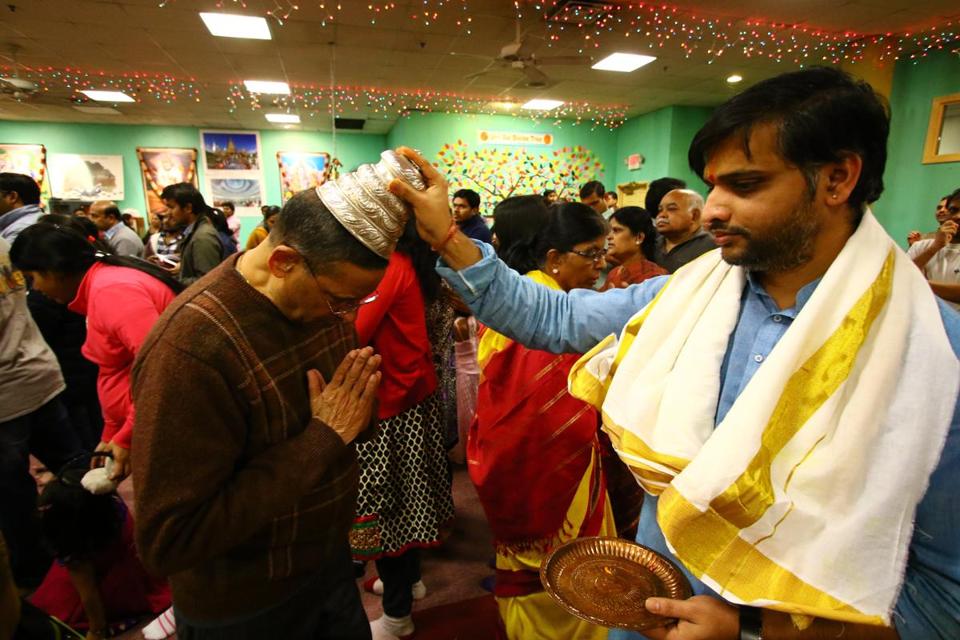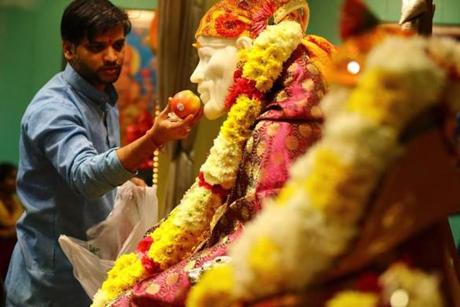 The temple’s priest, Satish Sharma, blessed one of the devotees with a shatagopam.
The temple’s priest, Satish Sharma, blessed one of the devotees with a shatagopam.
By Hattie Bernstein GLOBE CORRESPONDENT JANUARY 29, 2016
Shoes and boots piled up by the door. Melting snow tracked in with bits of sand. And bare or stockinged feet crossing the threshold into the sanctuary where families stand together or sit on the floor, singing, praying, lighting candles and incense.
This is Thursday at the New England Shirdi Sai Parivaar Temple in Chelmsford, a holy day for the Hindu followers of the guru Shri Sai Baba, the equivalent of Sunday for Christians, Friday for Muslims, or Saturday for Jews.
But today is also Makar Sankranti, a children’s festival that honors the sun, reminding everyone that the days are growing longer, the pitch-black nights are shortening, and spring is on the way.
About 300 worshippers have traveled from across town and from nearby Westford, Acton, Boxborough, Lowell, Shrewsbury, Lexington, and Nashua to attend the 8 p.m. service and community meal that follows — not an easy feat on a weekday evening for working parents and their children.
The temple’s priest, Satish Sharma, made an offering of food during the Jan. 14 service in Chelmsford.
Sharma made an offering of food during the Jan. 14 service in Chelmsford.
“It’s tough for me to make it happen,” says Dr. Makunda Dogiparthi, a dentist who lives in Nashua with her husband, a software engineer, and their two children. “We’re exhausted after a long day. . . . But we’re all committed to this. It’s planned, not a surprise for the family. Thursday, we are all going to the temple. Period. No excuses.”
Almost 10 years ago, followers of the guru began meeting in a small rented space in Dracut. In 2010, after they outgrew that building, they moved to the current 7,000-square-foot sanctuary in Chelmsford. And at the end of 2016, the temple will move again, to occupy a 40,000-square-foot building under construction on Route 119 in Groton, near the Littleton town line.
Meanwhile, the number of Asian-Indian Americans moving to Massachusetts has burgeoned: According to the 2010 Census, the most recent data available, there were 77,177 Asian-Indian Americans living in Massachusetts, nearly half of them in Middlesex County. From 2000 to 2010, the state’s Asian-Indian American population increased by 76 percent, according to the Institute for Asian American Studies at the University of Massachusetts Boston.
The Groton temple, being built on 13 of 28 acres purchased two years ago, potentially will be one of the largest and most visible Hindu temples in Massachusetts. The state’s Hindu temples lack a central organization, but according to some estimates there are nearly 30 Massachusetts temples.
The first phase, an $8 million project now underway, includes a 100-foot buffer around the perimeter; a two-story, 40,000-square-foot sanctuary; a community kitchen; and a 250-space parking lot.
There will be more fund-raising to complete the second phase, an apartment building to house up to four priests, and still more to raise money for the third phase, a 500-seat auditorium for cultural events, education, and community programs.
Throughout the planning, prospective neighbors and abutters were invited to express their concerns, ask questions, and learn about the temple. At every stage, following in the footsteps of their guru, temple officers listened and made accommodations.
“The site plan review process went very smoothly,” said Groton town planner Michelle Collette. The temple representatives and the general contractor, NM Construction Corp. of Reading, “were receptive to working with the abutters to minimize disturbance.”
And temple officers were eager to work with the other faith communities in town.
The Groton construction site for the future temple.
“They approached us last year. They’ve participated in our meetings, reached out,” said Shua Khan Arshad, president of the Groton Interfaith Council, adding that the temple’s spiritual and prayer services director, Neelkanth Mishra, is a member of the board. “Not all faith communities do that.”
‘He said all religions teach the same things. He always responded with kindness.’
Mahender Sing, temple president, speaking of guru Shri Sai Baba
Quote Icon
Unlike Islam, Judaism, or Christianity, Hinduism is not one religion, but a way of life. There is no single founder, no single scripture, and no commonly agreed upon teachings.
Followers of Shri Sai Baba, who lived in the late 19th and early 20th centuries in a small town about 100 miles from Mumbai, are committed to social justice. They volunteer at soup kitchens and shelters. They run free medical and dental camps for uninsured people, and they contribute to blood drives. Their only rule is that neither alcohol nor meat is allowed in the temple.
“His teachings never had a religious color,” said Mahender Singh, president of the temple and the vice president of a local software engineering company. “He said all religions teach the same things. He always responded with kindness.”
On Thursday evening, worshippers are carrying flowers to the two marble statues on the altar, gifts offered to the deity in return for blessings. Little girls in puffy skirts are laughing shyly, within arm’s length of their parents. Incense carries the scent of jasmine. Music is playing. Someone rings a bell.
In the kitchen, the volunteer cooks are preparing for the line that will soon be forming. “Shanti, shanti shanti.” Peace, peace, peace, a priest chants.
Peace within. Peace with each other. Peace in the world.
The Hindu temple follows the guru Shri Sai Baba, who was born in the 19th century.







